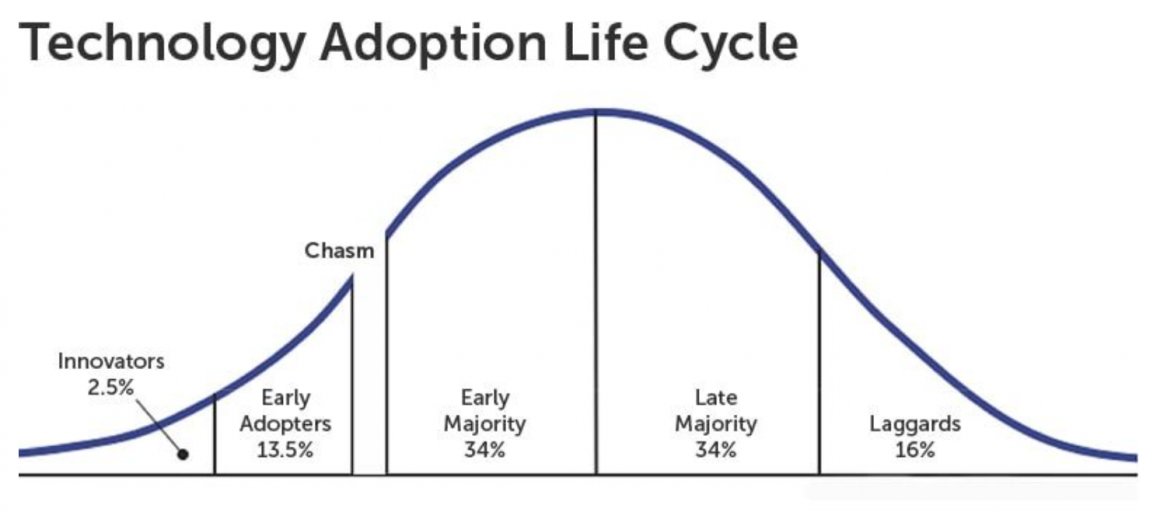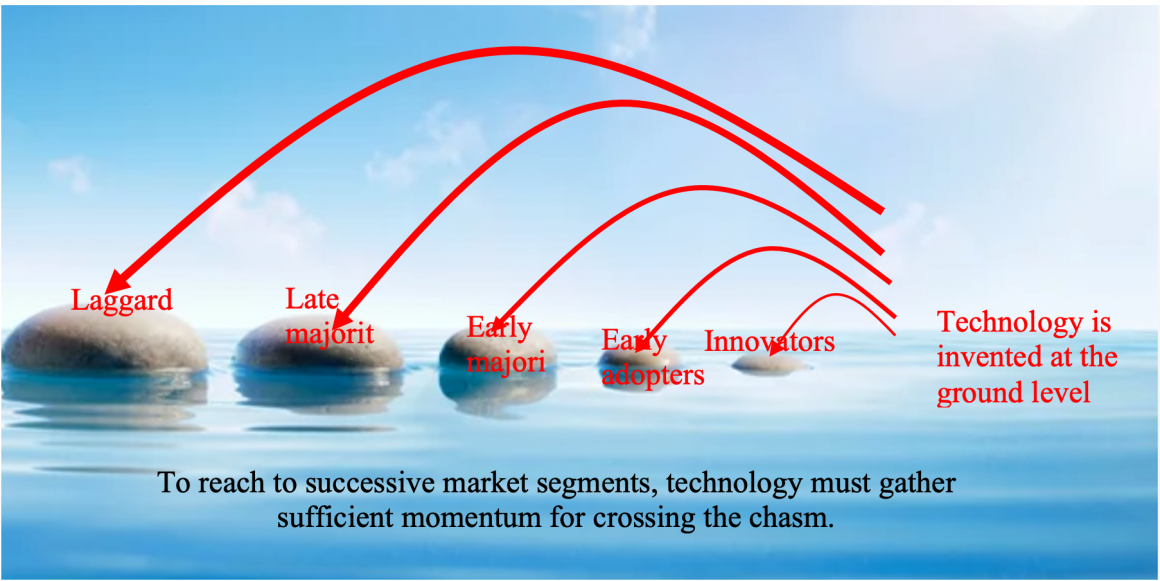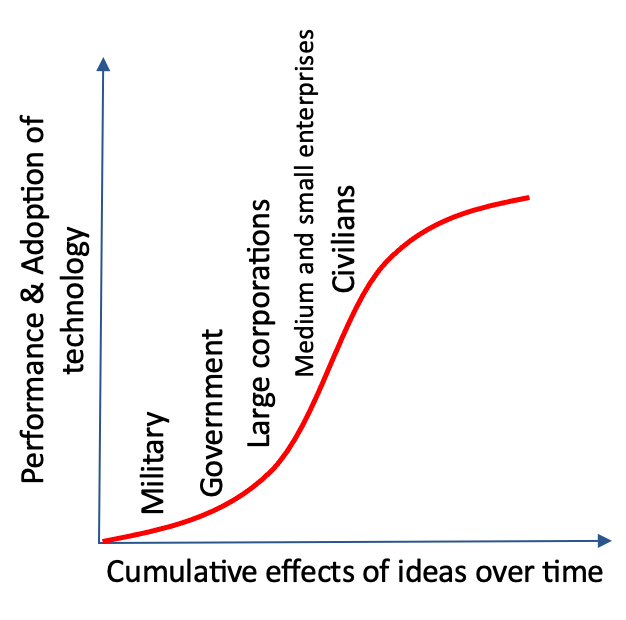In the technology adoption lifecycle, the gap between successive market segments is a chasm. As opposed to flat land, technology diffusion landscape is like a mountain. Invariably, inventions take place at the ground level. But customers are sitting at different altitudes of the mountain. Hence, crossing technology chasm is about adding momentum to technologies to reach successive higher-level market segments. Due to this reality, conventional marketing strategies fail. Customers sitting at different altitudes do not show similar characteristics. Hence, deciding about positioning technology products, building a marketing strategy, choosing the appropriate distribution channel and pricing should take into altitude or distance specific characteristics. Most importantly, technology progression is a must for improving the quality and reducing the cost for gaining momentum to reach higher altitude customers. Leveraging such a reality is at the core of succeeding with invention or Reinvention waves out of emerging technologies for creating Blue ocean opportunity.
Still today, our understanding of technology adoption is around the Innovation diffusion theory of Everett Rogers. Despite its high success in explaining how innovation as a public good succeeds in diffusing through different segments of society, it badly fails to interpret how technology adoption occurs. Unlike a static view of innovation, technology adoption is guided by a dynamic perspective.
For example, despite the adoption by innovators, the same technology cannot reach the remaining market segments unless technology itself gains further momentum. And that momentum does not show up from mere conventional information sharing, awareness building, trial, demonstration, incentives, and many others. At the heart of climbing higher levels or jumping to the next level, technology must gain momentum from quality advancement and cost reduction. Hence, irrespective of the effort, the same technology cannot reach all other market segments with one go. It’s a stepwise process, often taking decades and centuries.
Unlike Geoffrey Moore’s crossing the Chasm and Everett Rogers’ innovation diffusion theory:
So far, Everett Roger’s innovation diffusion theory is our thinking framework to understand how innovation diffuses in society. Concerning varying responses of different groups to an innovation, Rogers segmented the market as innovators, early adopters, early majority, later majority, and laggard. However, he derived the theory to explain the pattern of diffusion of innovation as public goods, which appears to be linear in progress.

In detecting the gap between the response of successive two segments to technology innovation, Geoffrey Moore introduced a term—Chasm. Subsequently, he updated Roger’s innovation diffusion model as crossing the chasm. But, both of them considered innovation as static. They assumed that the same innovation would pass through all segments of customers. That makes sense in explaining the diffusion or adoption pattern of a particular version of the technology. But a single version does not cross through all the market segments.
However, that appears to be a significant deviation from reality in retrospect. Technology adoption progresses from one segment to the next due to technology advancement. In its absence, the same level of technology maturity will not keep penetrating through all the segments. It appears that a technology spends the whole life cycle in keep progressing through different market segments. Eventually, every technology runs out of steam to complete the journey of progressing through all the customer segments. Hence, technology inventions go through reinventions for finding successive, more powerful waves for reaching deeper in society.
Pre-Chasm:

As we know, more or less, all technology inventions emerge in primitive form. In the beginning, they offer no economic value. Hence, nobody is willing to pay whether the customer is an innovator, early adopter, or laggard. For example, Edison could not find customers for its Phonograph. Similarly, upon making the digital camera prototype in 1974, Kodak gave it up. Hence, technology invention must proceed further to be helpful for any category of customers.
For this reason, Sony had to invest in R&D for more than a decade to make the Nobel Prize-winning CCD invention suitable enough to roll out innovations. Hence, we refer to this gap between the invention and further maturity for the initial rollout as the pre-chasm. This pre-chasm period may last for 10 to 100 years. For example, LCDs took almost 100 years to reach the innovator segment of Everett Rogers’ customer categories.
Innovators: first leg in crossing technology chasm

Who belongs to this innovator category? For technology, are innovator category customers just curious to try something new? In hindsight, No. They are the potential customers who cannot get their pressing jobs done with existing technology means. In retrospect, with respect to the Transistor radio, they were American college students who couldn’t use cabinet top radios to enjoy ‘rock n roll’ music with their friends in neighborhood cafes. They were military who were happy with a primitive airplane to drop bombs on enemies. In the language of Prof. Clayton Christensen, they belong to the non-consumption category. They are rare, but their role is vital. Hence, innovators must carefully find those customers for a primitive solution out of invented technologies. Often, they belong to the military.
Government agencies are the early adopters for many technologies, followed by large and medium-sized corporations belonging to the early majority. It happens to be the civilians are in the category of late majority and laggard. For technology to be attractive to later segments, it should keep improving further. Contrary to conventional belief, laggards demand the most sophisticated technology version. For example, smartphones in the late 1990s were of no use to rural farmers of Bangladesh. The technology had to improve very far, in terms of quality and cost, to be adopted by them.

Crossing technology chasm for reaching early adopters to laggard:
The same level of technology adopted by innovators does not keep diffusing through other segments, from early adopters to laggards. For example, the cellular phone used by the US military in the 1940s was of no use to civilians belonging to the late majority and laggard. To reach other segments, sitting at higher altitudes or further away, technology should progress in the form of quality advancement and cost reduction. It happens that there is an increased gap of technology maturity, forming a chasm for making the technology suitable for successive segments. To overcome these chasms, there should be a continued progression of technology.
In retrospect, not all technologies succeed in crossing chasms for reaching all the market segments. For example, gasoline automobiles have been facing a barrier to reach the late majority and laggards because of pollution and cost. Hence, it’s now reinvented by changing the technology core. Similarly, for expanding the reach of the light bulb, it got reinvented twice, ending up being an LED light bulb.
Reaching maturity and embarking on reinvention for achieving higher level:
As explained, many technologies reach maturity before climbing or jumping all the way through to reach all segments of the customers. Hence, the technology cores of significant products are being changed. Starting from telephone to television, there have been many examples. However, reinvented waves do not show up as a better alternative. Fortunately, in many cases, due to the amenability of progression of preferred emerging technology cores, some of those reinvented waves reach further market segments.
Crossing technology chasm is far more than a marketing exercise:
Crossing technology chasm is about advancing technologies for reaching segments residing at higher altitudes. At the same level of maturity, technology does not reach all the customer segments. For achieving higher-level market segments, technology must progress in quality and cost. Furthermore, more or less all technologies run out of the capability of growing further before penetrating through all the segments.
...welcome to join us. We are on a mission to develop an enlightened community by sharing the insights of Wealth creation out of technology possibilities as reoccuring patters. If you like the article, you may encourage us by sharing it through social media to enlighten others.


